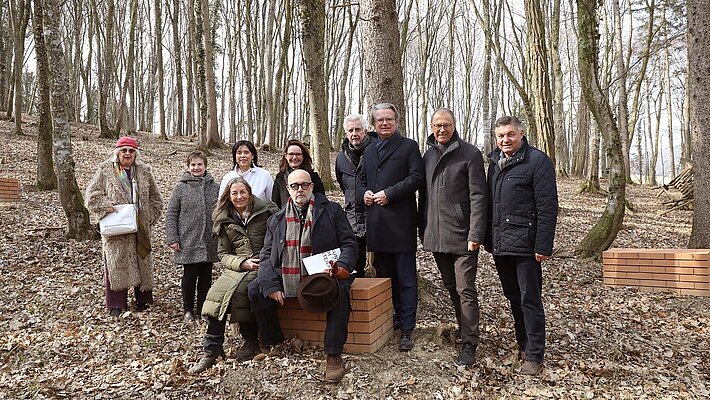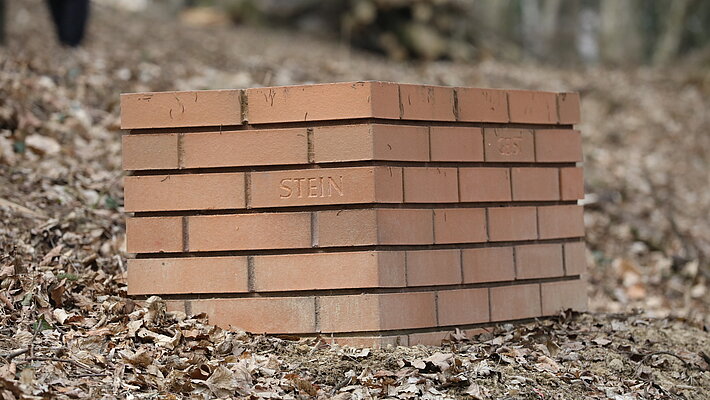|
|
|
|
|
|
08.03.2022
Following an invitation from curator Peter Pakesch, Pedro Cabrita Reis, a renowned Portuguese contemporary artist, was fascinated by the material commonly used in south-eastern Styria and the architecture found here. With his work Assembly/Versammlung, he rethinks the outward appearance and history of bricks in the region and opens a new, poetic space with the (furniture) sculpture in a patch of forest near Poppendorf Castle, which invites people to congregate and contemplate. The work was opened to the public on March 7, 2022 by the Institute for Art in Public Space Styria, the municipality of Gnas and the Province of Styria along with Ingrid Wiener, Vice Mayor Elisabeth Triebl, Member of the National Council Agnes Totter, Head of Universalmuseum Joanneum Alexia Getzinger, Curator and Project Initiator Peter Pakesch, Provincial Council for Culture Christopher Drexler, Head of Universalmuseum Joanneum Wolfgang Muchitsch, Mayor Gerhard Meixner, and in front Head Institute for Art in Public Space Styria Elisabeth Fiedler, Artist Pedro Cabrita Reis
|
|

Opening of "Assembly" by Pedro Cabrita Reis (sitting), Photo: Universalmuseum Joanneum/J.J. Kucek
|
|
|
|
|
|
|
|
|
|
|
|
The brick has accompanied humankind for millennia. As the first human-made building material, the brick served the Sumerians as a carrier for cuneiform characters, and they even considered it to be of divine origin. Brick was introduced to Styria in Roman times and promoted by Archduke Johann in the 19th century as a fireproof construction material – in contrast to widely available wood. Brick lattices spread throughout in the Alps-Adriatic region mainly due to the fact that the lattice surfaces allowed good ventilation of the stored hay.
Pedro Cabrita Reis deals with this material and its history in the work Assembly/Versammlung. 21 benches made up of bricks are arranged in the rhythm of the existing flora and at the same time create an open and quiet space in the middle of the forest next to Poppendorf Castle. Reis seizes upon the myth of the forest as well as the history of the building material and points out the connection between nature and art in the working materials of the present and the past. Through just as many lyrical word pairs engraved on the individual objects, a poetic dimension that can be charged with additional meanings emerges. “Ocean” and “Forest,” “Moon” and “Window” or “Mouth” and “water” encounter each other.
|
|

"Assembly" by Pedro Cabrita Reis in Gnas, Styria, Photo: Universalmuseum Joanneum/J.J. Kucek
|
|
|
|
|
|
|
|
|
|
|
|
|
Assembly/Versammlung is therefore not only to be understood as a space itself, but also gives us a place to pause, reflect, alone or together, inspired by the word pairs or the sounds of the surrounding nature. Pedro Cabrita Reis opens a sphere that stores and provides energy, revealing to us the secrets of the forest and of thought.
____________________
Pedro Cabrita Reis
Assembly/Versammlung
permanent installation in the forest next to castle Poppendorf, Poppendorf 1, 8342 Gnas
46°51'24.3"N 15°51'25.4"E
A project by the Institute for Art in Public Space Styria
www.kioer.at
____________________
We are looking forward to your coverage.
Best regards
Daniela Teuschler
+43/664/8017-9214, daniela.teuschler@museum-joanneum.at
Stephanie Liebmann
+43/664/8017-9213, stephanie.liebmann@museum-joanneum.at
Alexandra Reischl
+43/699/1780-9002, alexandra.reischl@museum-joanneum.at
|
|
|
|
|
|
|
|